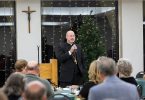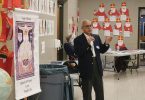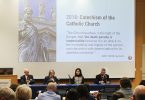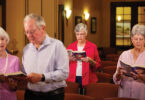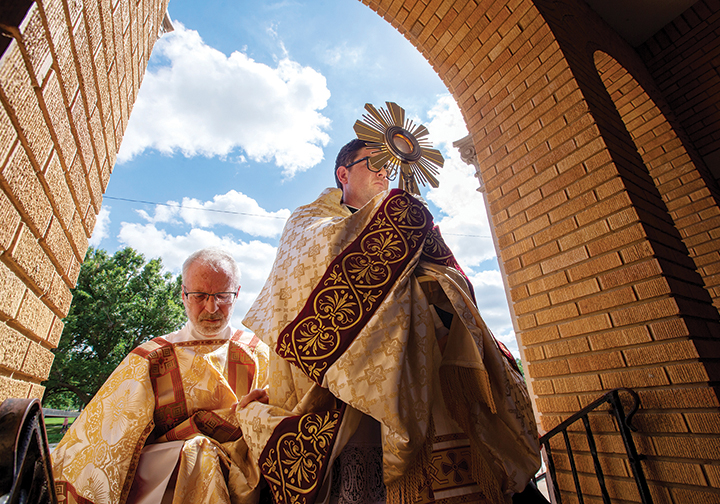
by Todd Habiger
todd.habiger@theleaven.org
NORTONVILLE — Five-year-old Hannah Lock had lots of questions about the National Eucharistic Pilgrimage that passed through here on June 25. But her most pressing one was: “Where is Jesus?”
“She thought Jesus was one of the priests,” said her mother, Kayla Lock, a member of St. Augustine Parish in Fidelity.
While the explanation that Jesus was present in the Eucharist in the monstrance may have slightly disappointed Hannah, hundreds of others that took part in the pilgrimage were delighted to have the opportunity to see and process with the eucharistic Christ as pilgrims made their way through the Archdiocese of Kansas City in Kansas June 24-29.
The travelers
“It was so beautiful,” said Rachael Schmidt, a member of St. Mary Parish, Derby, who attended the Atchison leg of the pilgrimage. “It’s an amazing witness of processing all across America with Jesus.”
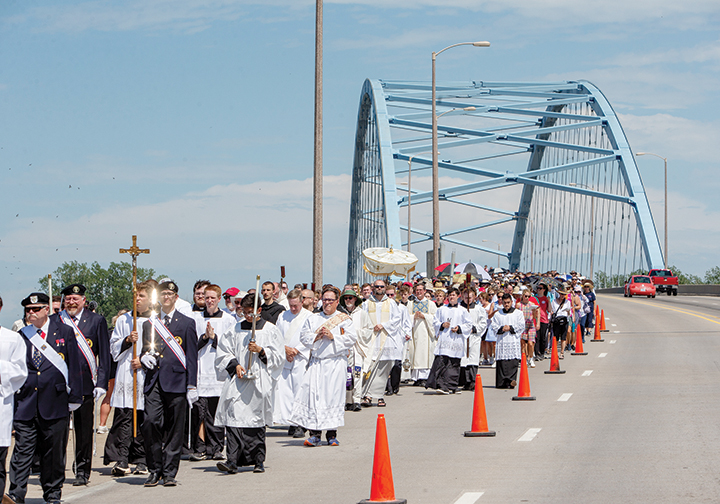
Schmidt, who will be a freshman at Benedictine College in the fall, said she knew the pilgrimage was going to be a powerful event.
“I couldn’t miss it,” she said. “People everywhere are going to see this and wonder what is going on and see all these people following Jesus.”
The National Eucharistic Pilgrimage is actually four different eucharistic pilgrimages traveling across the United States. The Serra Route, which started in San Francisco, is the pilgrimage that passed through the archdiocese. There is also the Marian Route that started in Lake Itasca, Minnesota; the Seton Route that started in New Haven, Connecticut; and the Juan Diego Route that started in Brownsville, Texas.
Each route will converge on Indianapolis on July 16 and kick off the start of the National Eucharistic Congress, which will be held at Lucas Oil Stadium July 17-21.
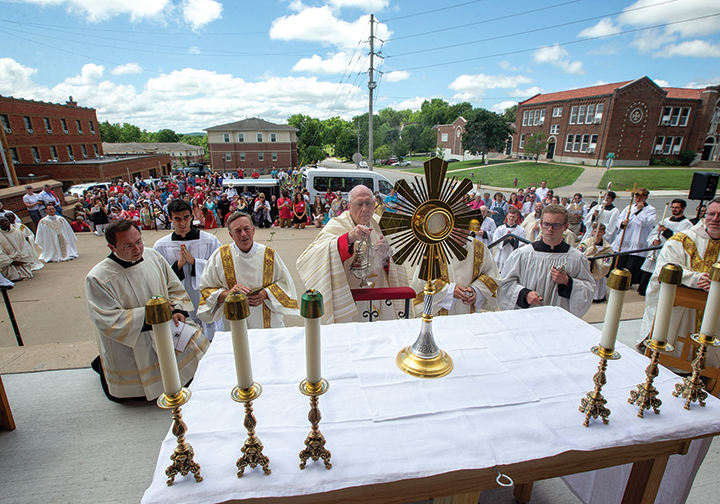
Some people traveled long distances to be a part of this pilgrimage.
Lucy Reyes, a member of St. Matthew Parish in Charlotte, North Carolina, was one such pilgrim. Reyes joined the procession in Atchison. Traveling with her sister-in-law, who is from Florida, Reyes said being part of the pilgrimage was deeply moving.
“It’s awesome. It’s amazing,” she said. “The community around the Eucharist was so overwhelming. It’s just beautiful.”
The pilgrimage entered the archdiocese on a blistering hot afternoon, crossing from Missouri over into Kansas via the Amelia Earhart Bridge on June 25. Sweat dripped down the faces and saturated the clothes of the pilgrims, as the body of Christ made its way to Benedictine College in Atchison. The following day, pilgrims processed through the verdant campus of Benedictine College, the dusty roads of Nortonville and the busy streets of downtown Topeka.
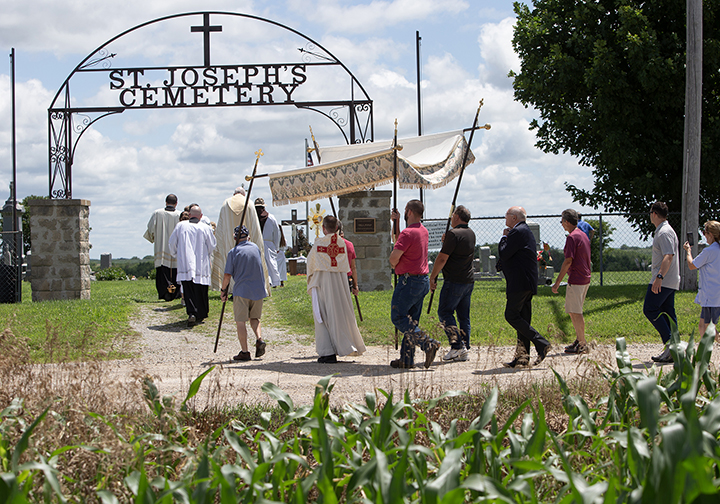
Each stop along the way offered an opportunity to adore and/or process with the Blessed Sacrament. St. Joseph Parish in Nortonville relished the opportunity to be part of the pilgrimage.
“It’s overwhelming to consider that a little rural parish with less than 100 families is important enough to be a stop on this national pilgrimage,” said Becky Weishaar, a member of St. Joseph. “To think that this has been making its way all the way from California and will be a huge part of that Eucharistic Revival in Indianapolis is very exciting to us to bring people closer to the Lord in the real presence of Christ.”
They have come
On a national level, interest in the pilgrimages has exceeded expectations. The archdiocesan leg has been no exception, as most churches have been standing room only for eucharistic adoration, Masses and Holy Hours.
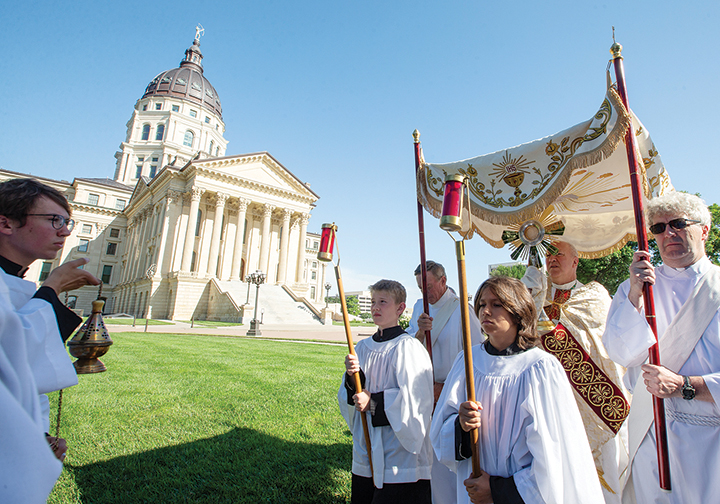
“It’s hard to plan for an event when you don’t know how many people are coming, but the Lord provides,” said Father Nathan Haverland, pastor of Most Pure Heart of Mary Parish in Topeka and one of the organizers of the Topeka portion of the pilgrimage. “We planned the best that we could and he provides for the rest.”
Hundreds of pilgrims processed from St. Joseph Church in Topeka to Assumption Church. At Assumption, the church was packed to capacity and beyond.
“Assumption was completely full today, which was a beautiful sight,” said Father Haverland. “We had no idea what to plan for, what the turnout would be, but we knew the numbers would be big. This is certainly a lot bigger than we thought.”
A lesson in history
June 27 began with Mass at Assumption — standing room only again — followed by a procession to the Brown v. Board of Education National Historical Park where, at a prayer service, Archbishop Joseph F. Naumann noted the importance of the Brown Supreme Court decision and its role in combating racism.
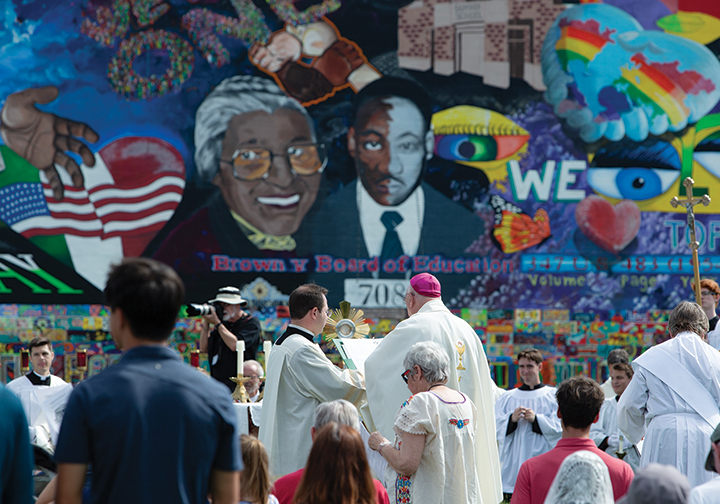
“Every time we leave Mass, we’re sent on a mission to change the world and to bring Jesus Christ to every corner of society. We give thanks to all those who were instrumental in this landmark decision that ended segregation in our schools,” he said.
The archbishop said it was a great moment for the church and the pilgrimage to stop at the park and recognize the sacrifices that have been made for racial equality.
The gravity of the moment wasn’t lost on Deacon Dana Nearmyer, division secretary for evangelization in the archdiocese.
“I was moved to be there with men and women who have fought for decades for racial justice and eucharistic amazement,” he said.
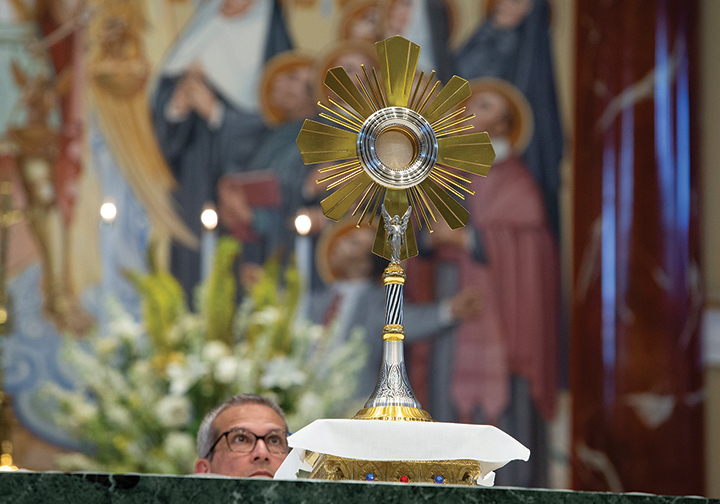
Following the Brown service, the pilgrimage shifted to Corpus Christi Parish in Lawrence for lunch, eucharistic adoration and a Holy Hour and then on to Leawood, where the Eucharist processed from the Talk of the Town parking lot to St. Michael the Archangel Parish, where the Blessed Sacrament was present for eucharistic adoration and Mass.
The power of the Eucharist
The following day began what was called the Mission on Mission Road. A procession started at Church of the Nativity in Leawood and ended up at Tomahawk Creek Park. From there, the pilgrimage moved to Curé of Ars Parish, where the group processed to Franklin Park. From Franklin Park, the Eucharist moved to St. Agnes Parish in Roeland Park for an hour of eucharistic adoration, lunch and then on to Donnelly College in Kansas City, Kansas. From Donnelly, pilgrims processed to the Cathedral of St. Peter to end its day.
Most of the faithful joined the pilgrimage at one — or at most two — of the stops of the National Eucharistic Pilgrimage. But several young people — known as perpetual pilgrims — have been with the pilgrimage since it started on June 16.
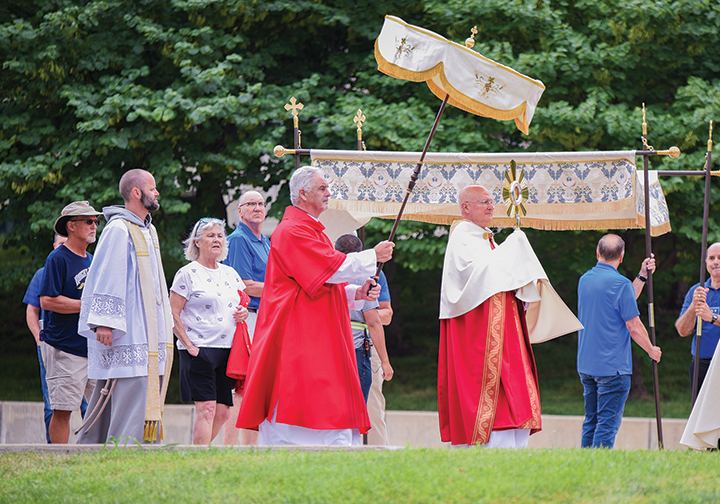
Jimmy Velasco, a seminarian for the Diocese of San Francisco, is one of these perpetual pilgrims and has been there every step of the way.
Velasco said it’s been very gratifying to travel with the Lord and to meet the people in different states and communities, all who have a love for the Lord and the Eucharist.
But Velasco said the trip hasn’t been without its challenges.
“This is a really long trip. It’s never been done before. It’s two months. It’s two months away from family. Two months away from home,” he said. “You have to be very adaptable. A lot of things come up that are unprecedented and alter our plans.”
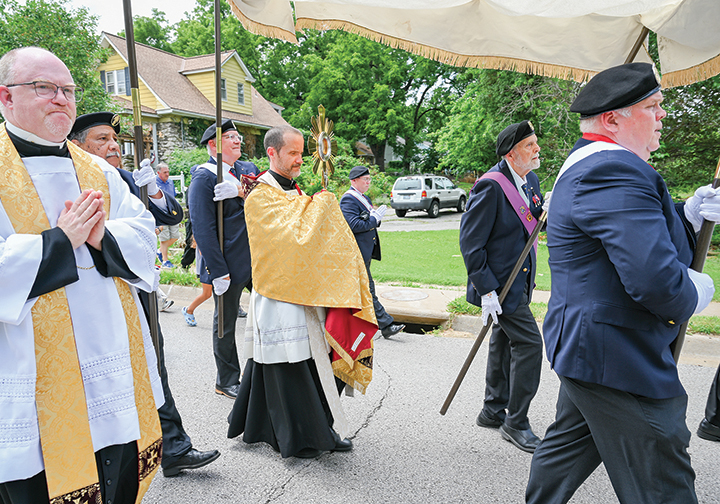
Archbishop Naumann praised the perpetual pilgrims for their faith and commitment to the pilgrimage.
“These young adult pilgrims, it’s beautiful that they have given this time — basically two months — walking with Jesus, driving with Jesus,” he said. “Thank you for your love for Jesus and your love for the Eucharist.”
The Franciscan Friars of the Renewal are the official chaplains for the National Eucharistic Pilgrimage. A different friar joins the pilgrimage every week or two to care for the body of Christ, as well as the perpetual pilgrims.

Father Innocent, CFR, who joined up with the pilgrimage in Nebraska, said that he has been inspired as he’s traveled with the group.
“Every procession I’ve walked, either when I’m holding Jesus in the monstrance or I’m seeing the faces of the people, I realize how close Jesus wants to be with us,” he said. “I look over in the monstrance and think ‘Man, Jesus is here.’”
On June 29, the archdiocesan leg of the pilgrimage ended with the celebration of Mass at the cathedral by Archbishop Naumann, after which the Blessed Sacrament was off on the next stage of the journey, and the perpetual pilgrims headed to their final destination in Indianapolis.
To view the full album of photos from the pilgrimage in northeast Kansas, click here.



